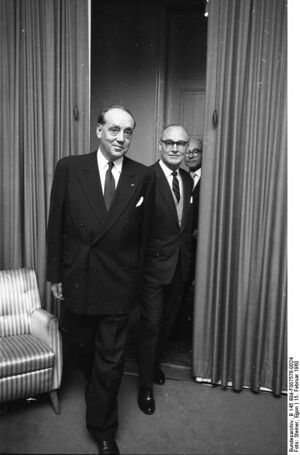Arne Skaug
( economist, civil servant, diplomat, politician) | ||||||||||
|---|---|---|---|---|---|---|---|---|---|---|
 Skaug visiting West Germany in 1960 | ||||||||||
| Born | 6 November 1906 Horten, Norway | |||||||||
| Died | 4 March 1974 (Age 67) Copenhagen, Denmark | |||||||||
| Nationality | Norwegian | |||||||||
| Alma mater | • Oslo Commerce School • London School of Economics • Oslo University | |||||||||
| Interests | Marshall Plan | |||||||||
| Party | Labour Party (Norway) | |||||||||
Norwegian transatlantic Labour politician who was made Ambassador to the UK the year after attending the 1961 Bilderberg
| ||||||||||
Not to be confused with politician Arne Skauge
Arne Skaug a Norwegian transatlantic economist, politician and diplomat. He attended the Bretton Woods Conference and the first meeting on the Marshall Plan in Paris in 1947, was ambassador to the OEEC in Paris from 1949 and also to NATO from 1952; he was minister of trade 1955-61 and ambassador to London 1962-68 and to Copenhagen 1968-74.
He attended the 1961 Bilderberg meeting.
Contents
Education
Skaug grew up in Horten. He then attended Oslo Commerce School and then began studying economics at the University of Oslo.[1]
Pre-war Career
After graduating in economics in 1930, Skaug began as secretary in Statistics Norway (SSB), where director Gunnar Jahn early gave him major tasks. He took over the management of the 1930 census and led a large corporate census in 1936.[1]
Skaug made contributions to social policy and economic issues in the Labour Party's educational work. Together with Aase Lionæs he published a book on economics in 1935 and an adapted version of Alva and Gunnar Myrdal's book on the crisis in the population question. He took an active part in the population debate that followed, both inside and outside the Labour Party.[1]
Skaug maintained contact with the University of Oslo, among others.a. through lectures. In 1935-36 he studied at the London School of Economics. He became a university research fellow in 1939, probably with a view to a university career. At the same time, war preparations began. Skaug was for a short time office manager in the newly established Ministry of supply before he went on a long planned study stay in the United States in the autumn of 1939.[1]
World War 2
Skaug's main interest was international migration and its economic causes. He was a Ph.D.- student at the University of Wisconsin, where for a time he also taught.[1]
When the war came in April 1940, Skaug volunteered for service to the Norwegian authorities. The Ministry of supply already wanted Skaug to go to London in 1941, but he did not arrive there until 1944. From 1942 he headed the Norwegian Social Security Office in New York and was increasingly drawn into international work. He participated in the conference in Hot Springs that laid the foundation for FAO, at UNRRA conferences 1943 and 1944 and was one of three Norwegian representatives at the Bretton Woods conference in 1944. From 1943, he was a trade advisor at the embassy in Washington, D.C.[1]
Post-war career
Skaug returned home at the end of July 1945 and became chairman of the Coordination Council, but by the autumn he was back in the United States as Trade Council. When Jahn became head of Norges Bank in 1946, Skaug was appointed director of Statistics Norway. After the war, tasks were queuing up in Statistics Norway, which lacked offices, qualified manpower and printing capacity. Skaug embarked on extensive changes and modernization.[1]
At the same time, Skaug was widely used for international tasks. He participated in the discussions on an International Trade Organization in Geneva 1947 and Havana 1947-48, and he was instrumental in the establishment of the United Nations Economic Commission for Europe. He also attended the first meeting on the Marshall Plan in Paris in 1947 and was appointed secretary of state the following year to complete negotiations on the Marshall Plan. He became minister, later ambassador and Norway's permanent delegate to the OEEC from 1949 and to NATO from 1952.[1]
As Minister of trade in Einar Gerhardsen's government from January 1955 played an important role in the restructuring of economic policy. He was a strong advocate of European and Atlantic cooperation and a key player in negotiations and discussions. He became ambassador to London in 1962 and to Copenhagen in 1968.[1]
He worked behind the scenes for a Norwegian membersip in the EEC (later EU), which failed in a 1971 referendum.[2]
Event Participated in
| Event | Start | End | Location(s) | Description |
|---|---|---|---|---|
| Bilderberg/1961 | 21 April 1961 | 23 April 1961 | Canada Quebec St-Castin | The 10th Bilderberg, the first in Canada and the 2nd outside Europe. |